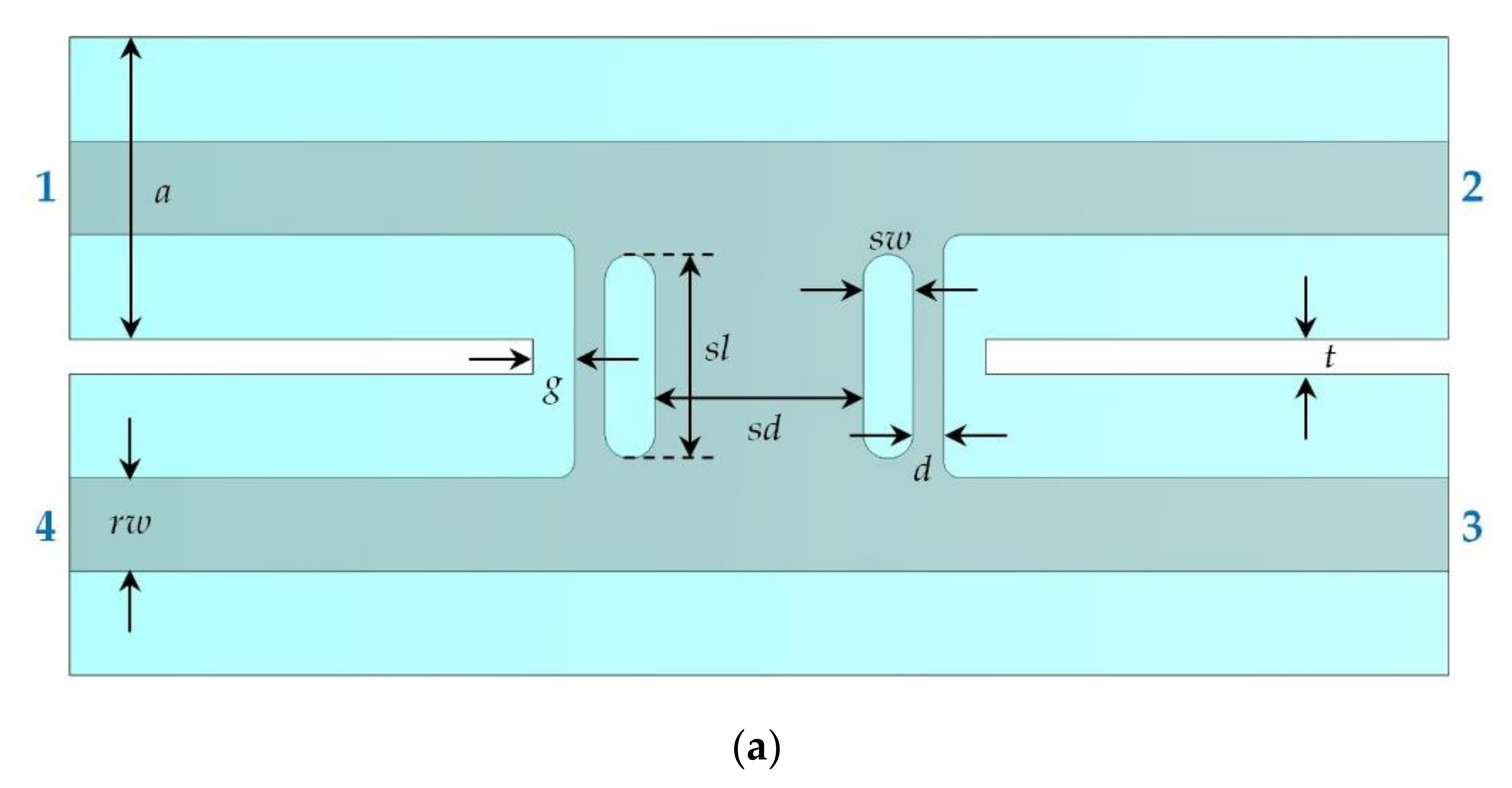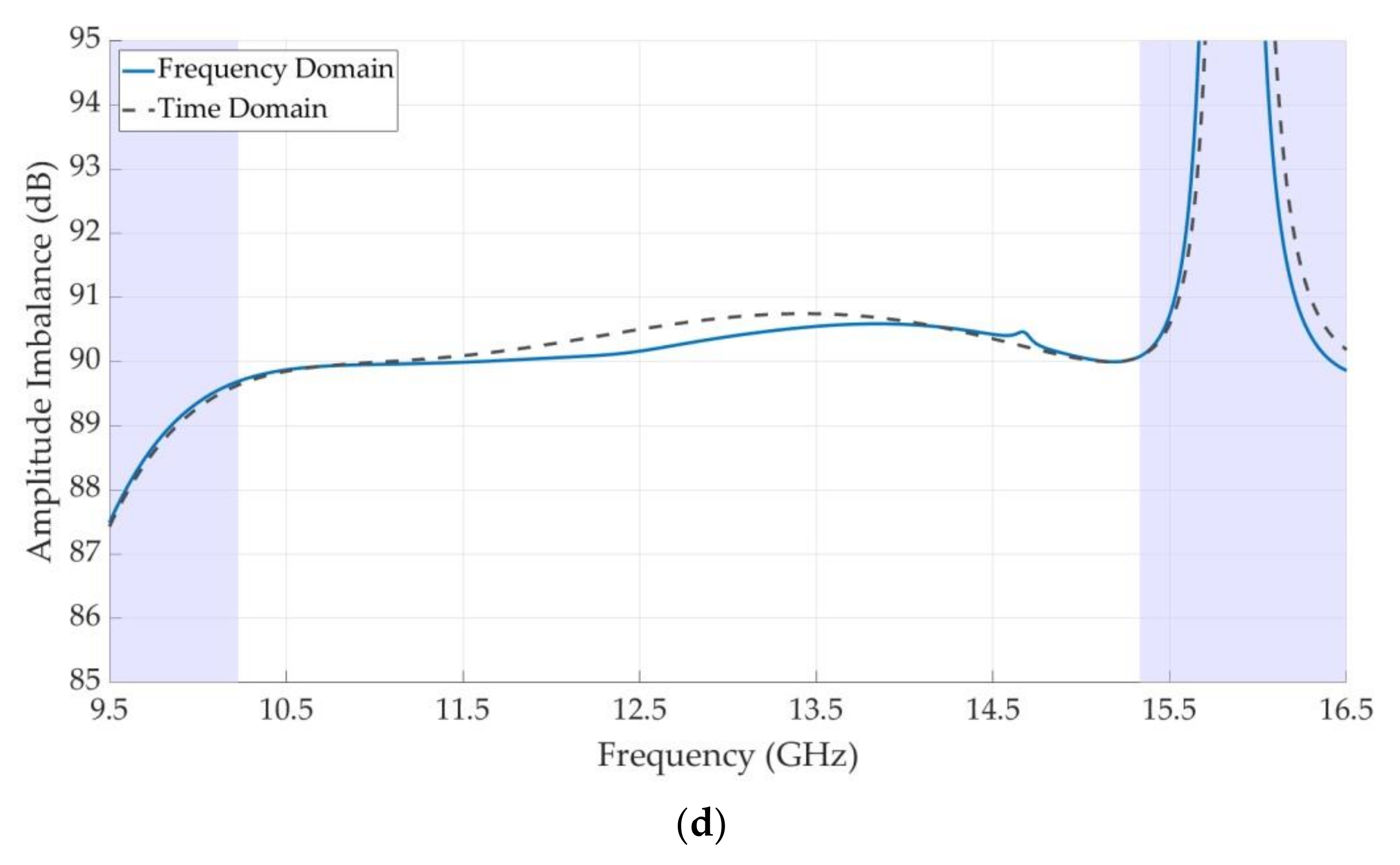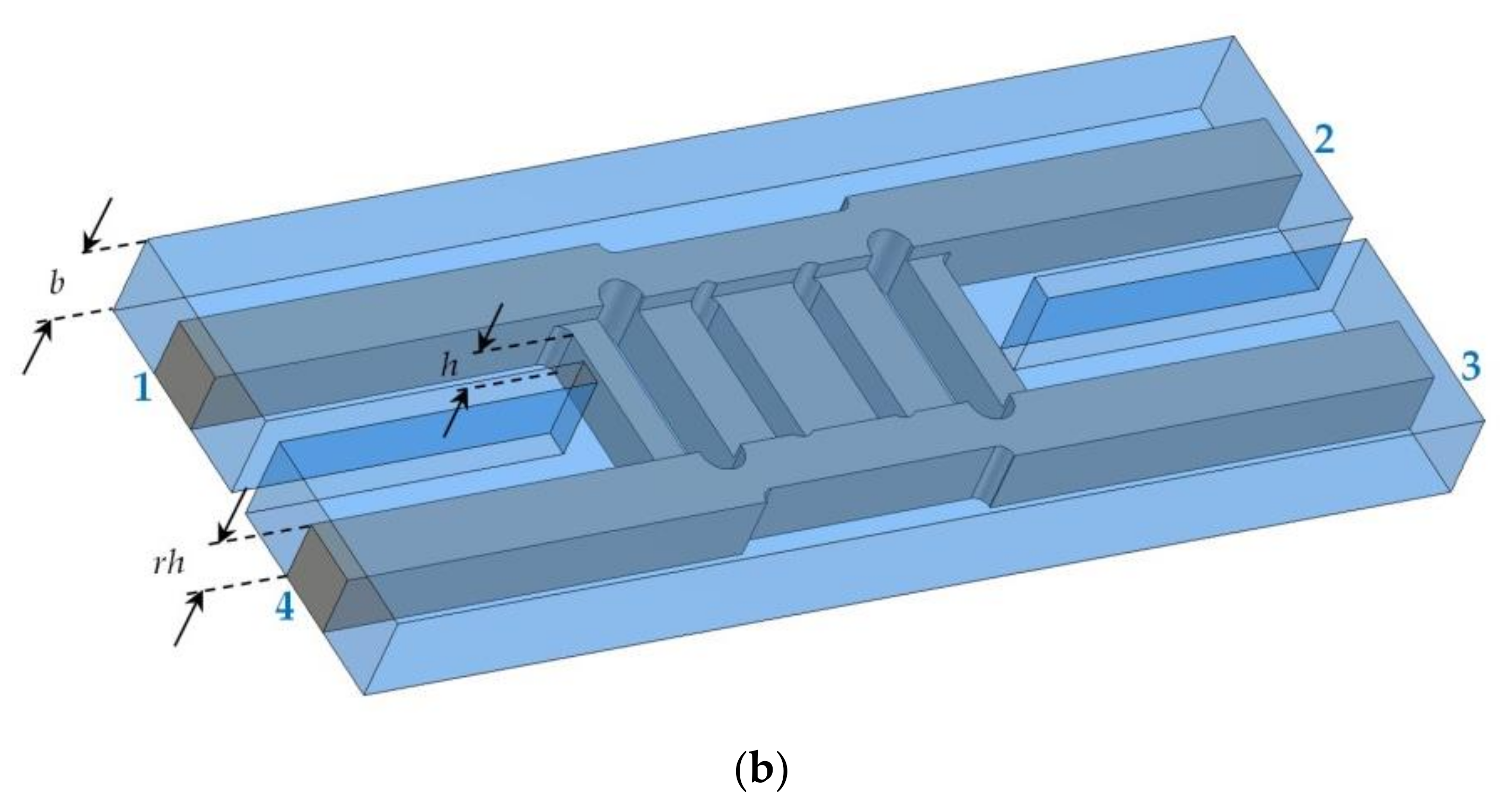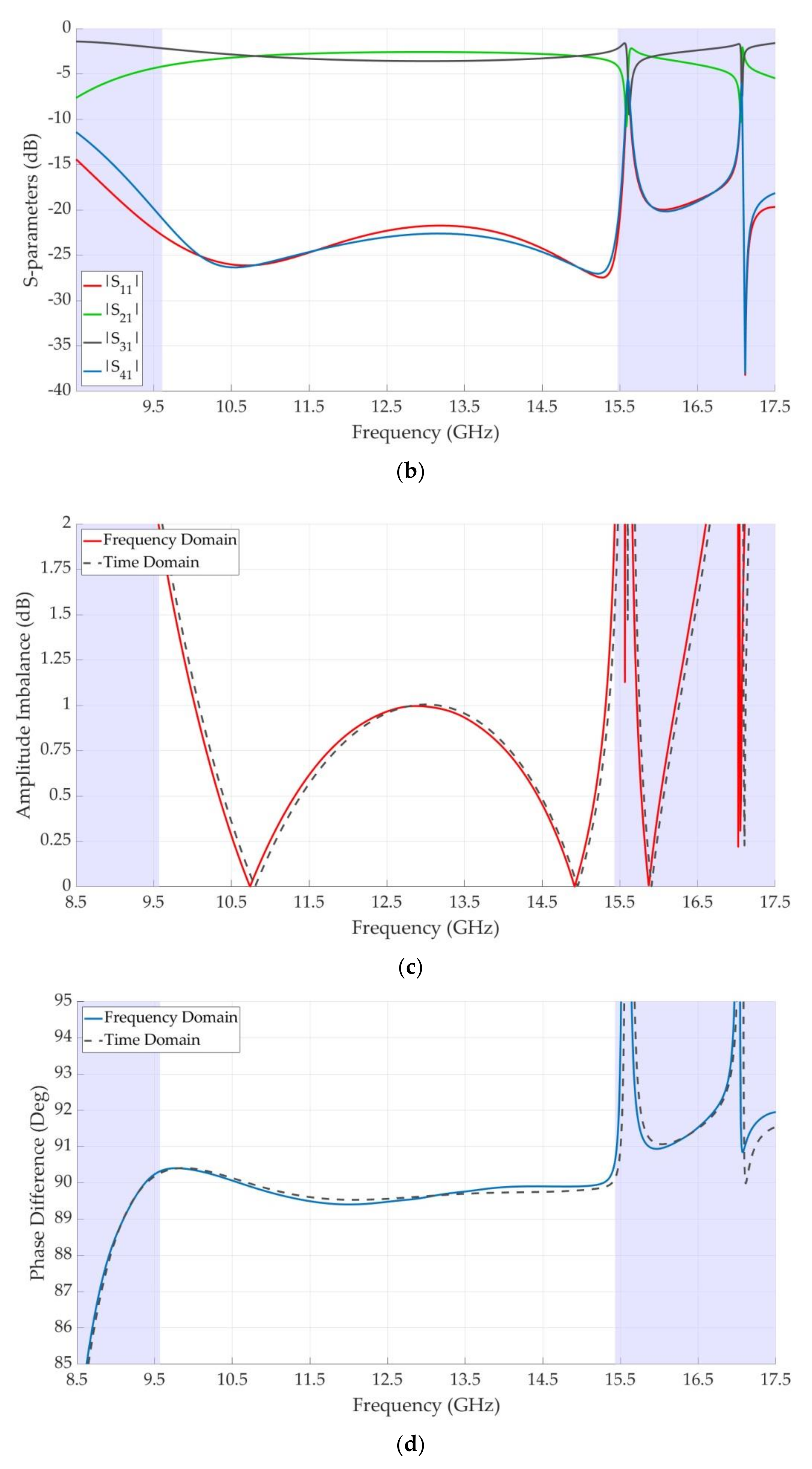Single-Ridge Waveguide Compact and Wideband Hybrid Couplers for X/Ku-Band Applications
Abstract
:1. Introduction
2. Design
3. Comparison with the State of the Art
4. Tolerance Analysis
5. Conclusions
Author Contributions
Funding
Data Availability Statement
Conflicts of Interest
References
- Pozar, D.M. Microwave Engineering, 4th ed.; John Wiley & Sons: Hoboken, NJ, USA, 2011. [Google Scholar]
- Nasr, A.M.H.; Safwat, A.M.E. Tightly coupled directional coupler using slotted-microstrip line. IEEE. Trans. Microw. Theory Tech. 2018, 66, 4462–4470. [Google Scholar] [CrossRef]
- Roshani, S.; Yahya, S.I.; Roshani, S.; Rostami, M. Design and fabrication of a compact branch-line coupler using resonators with wide harmonics suppression band. Electronics 2022, 11, 793. [Google Scholar] [CrossRef]
- Farahani, M.; Akbari, M.; Nedil, M.; Denidni, T.A.; Sebak, A.R. A novel low-loss millimeter-wave 3-db 90° ridge-gap coupler using large aperture progressive phase compensation. IEEE Access 2017, 5, 9610–9618. [Google Scholar] [CrossRef]
- Ali, M.M.M.; Shams, S.I.; Sebak, A.-R. Printed ridge gap waveguide 3-db coupler: Analysis and design procedure. IEEE Access 2018, 6, 8501–8509. [Google Scholar] [CrossRef]
- Dai, Y.-S.; Lu, Y.-L.; Luo, Q.-S.; Zhan, B.-Z.; Wang, X.; Jiang, Y.-B. A microminiature 3db multilayer double-octave hybrid coupler using ltcc. In Proceedings of the 2005 Asia-Pacific Microwave Conference, Suzhou, China, 4–7 December 2005; pp. 1–3. [Google Scholar] [CrossRef]
- Fahmi, M.M.; Ruiz-Cruz, J.A.; Zaki, K.A.; Piloto, A.J. Multilayer multi-section broadband ltcc stripline directional couplers. In Proceedings of the 2007 IEEE/MTT-S International Microwave Symposium, Honolulu, HI, USA, 3–8 June 2007; pp. 173–176. [Google Scholar] [CrossRef]
- Ruiz-Cruz, J.A.; Zhang, Y.; Zaki, K.A.; Piloto, A.J.; Rebollar, J.M. Ridge waveguide branch-line directional couplers for wideband applications and ltcc technology. In Proceedings of the IEEE MTT-S International Microwave Symposium Digest, Long Beach, CA, USA, 17 June 2005; pp. 1219–1222. [Google Scholar] [CrossRef]
- Wang, Y.; Fu, Y. A broadband waveguide power splitter and combiner using in spatial power combining amplifier. In Proceedings of the 2011 International Conference on Electronics, Communications and Control (ICECC), Ningbo, China, 9–11 September 2011; pp. 4074–4077. [Google Scholar] [CrossRef]
- Beyer, R.; Rosenberg, U. Compact top-wall hybrid/coupler design for extreme broad bandwidth applications. In Proceedings of the IEEE MTT-S International Microwave Symposium Digest, Long Beach, CA, USA, 17 June 2005; pp. 1227–1230. [Google Scholar] [CrossRef]
- Alfonso, E.; Zaman, A.U.; Pucci, E.; Kildal, P. Gap waveguide components for millimetre-wave systems: Couplers, filters, antennas, mmic packaging. In Proceedings of the 2012 International Symposium on Antennas and Propagation (ISAP), Nagoya, Japan, 29 October–2 November 2012; pp. 243–246. [Google Scholar]
- Zarifi, D.; Shater, A.R. Design of a 3-db directional coupler based on groove gap waveguide technology. Wiley Microw. Opt. Technol. Lett. 2017, 59, 1597–1600. [Google Scholar] [CrossRef]
- Gatti, R.V.; Rossi, R. A dual circularly polarized slot-fed horn array antenna with linear polarization-tracking feature. Wiley Int. J. RF Microw. Comput.-Aided Eng. 2018, 28, e21480. [Google Scholar] [CrossRef]
- Gatti, R.V.; Rossi, R. Wideband compact single-ridge waveguide to rectangular waveguide transitions with integrated e-plane bend. IET Electron. Lett. 2016, 52, 1699–1701. [Google Scholar] [CrossRef]
- Gatti, R.V.; Rossi, R.; Dionigi, M. X-band right-angle coaxial-to-single ridge waveguide compact transition with capacitive coupling. IET Electron. Lett. 2019, 55, 103–105. [Google Scholar] [CrossRef]
- Gatti, R.V.; Rossi, R. Single-ridge waveguide t-junctions for compact multilayer beam forming netwoks. Wiley Int. J. RF Microw. Comput.-Aided Eng. 2017, 27, e21056. [Google Scholar] [CrossRef] [Green Version]
- Shams, S.I.; Kishk, A.A. Design of 3-db hybrid coupler based on rgw technology. IEEE Trans. Microw. Theory Tech. 2017, 65, 3849–3855. [Google Scholar] [CrossRef]
- Soliman, M.Y.; Ali, M.M.M.; Shams, S.I.; Sree, M.F.A.; Fawzy, D.E.; Allam, A.M.M.A. Ridge gap waveguide wideband hybrid directional coupler for ka-band applications. In Proceedings of the 2020 7th International Conference on Electrical and Electronics Engineering (ICEEE), Antalya, Turkey, 14–16 April 2020; pp. 211–214. [Google Scholar] [CrossRef]
- Mahdavi, P.; Hosseini, S.E. Ku-band two-section branch-line coupler based on ridge gap waveguide technology. In Proceedings of the 2020 28th Iranian Conference on Electrical Engineering (ICEE), Tabriz, Iran, 4–6 August 2020; pp. 1–5. [Google Scholar] [CrossRef]
- Nasr, M.A.; Kishk, A.A. Analysis and design of broadband ridge-gap-waveguide tight and loose hybrid couplers. IEEE Trans. Microw. Theory Tech. 2020, 68, 3368–3378. [Google Scholar] [CrossRef]
- Fahmi, M.M.; Ruiz-Cruz, J.A.; Mansour, R.R. Contra-directional 3db 90° hybrid coupler in ridge waveguides using even and odd TE modes. In Proceedings of the 2019 IEEE MTT-S International Microwave Symposium (IMS), Boston, MA, USA, 2–7 June 2019; pp. 584–586. [Google Scholar] [CrossRef]
- Fahmi, M.M.; Ruiz-Cruz, J.A.; Mansour, R.R. Contra-directional ridge waveguide couplers: Design and applications. IEEE Trans. Microw. Theory Tech. 2019, 67, 4966–4975. [Google Scholar] [CrossRef]
- Fahmi, M.M.; Ruiz-Cruz, J.A.; Zaki, K.A. E and h-plane ridge waveguide couplers. Wiley Int. J. RF Microw. Comput.-Aided Eng. 2008, 18, 348–358. [Google Scholar] [CrossRef]










| Parameter | Description | HC1 Value (mm) |
|---|---|---|
| a | Waveguide width | 13.00 |
| b | Waveguide height | 5.50 |
| d | Slot distance from edge | 1.32 |
| g | Gap | 1.81 |
| rh | Ridge height | 4.00 |
| rw | Ridge width | 4.00 |
| sd | Slot separation | 8.98 |
| sl | Slot length | 8.81 |
| sw | Slot width | 2.17 |
| t | Wall thickness | 1.50 |
| Parameter | Description | HC2 Value (mm) | Parameter | Description | HC2 Value (mm) |
|---|---|---|---|---|---|
| a | Waveguide width | 13.00 | rw | Ridge width | 4.00 |
| b | Waveguide height | 5.50 | sd1 | Slot separation 1 | 4.75 |
| cx | Notch length | 7.79 | sd2 | Slot separation 2 | 3.13 |
| cw | Notch width | 0.82 | sl1 | Slot length 1 | 11.02 |
| d | Slot distance from edge | 1.97 | sl2 | Slot length 2 | 13.49 |
| g | Gap | 2.45 | sw1 | Slot width 1 | 1.66 |
| h | Central block height | 2.95 | sw2 | Slot width 2 | 2.57 |
| rh | Ridge height | 4.00 | t | Wall thickness | 1.50 |
| Reference | Technology | BW (GHz) | FBW (%) | Normalized Length (λ0) | Layers |
|---|---|---|---|---|---|
| [17] | RGW | 14.00–16.50 (1) | 16.39 | 1.57 | 1 |
| [18] | RGW | 31.80–35.50 | 11.00 | 1.60 | 1 |
| [19] | RGW | 13.00–17.00 (2) | 26.67 | 1.26 | 1 |
| [20] | RGW | 15.00–23.00 | 42.11 | 2.00 | 2 |
| [21] | SRW | 1.55–2.60 (2) | 50.60 | 0.40 | 2 |
| [22] | SRW | 4.25–5.75 | 30.00 | 0.48 | 2 |
| [23] | SRW | 4.00–7.70 | 63.25 | 3.50 | 1 |
| [23] | SRW | 3.15–5.35 | 51.76 | 1.00 | 4 |
| HC1 | SRW | 10.23–15.33 | 39.91 | 0.83 | 1 |
| HC2 | SRW | 9.57–15.43 | 46.88 | 1.18 | 1 |
| HC2 | SRW | 10.04–15.32 (3) | 41.64 | 1.20 | 1 |
Publisher’s Note: MDPI stays neutral with regard to jurisdictional claims in published maps and institutional affiliations. |
© 2022 by the authors. Licensee MDPI, Basel, Switzerland. This article is an open access article distributed under the terms and conditions of the Creative Commons Attribution (CC BY) license (https://creativecommons.org/licenses/by/4.0/).
Share and Cite
Simoncini, G.; Rossi, R.; Alimenti, F.; Vincenti Gatti, R. Single-Ridge Waveguide Compact and Wideband Hybrid Couplers for X/Ku-Band Applications. Electronics 2022, 11, 1538. https://doi.org/10.3390/electronics11101538
Simoncini G, Rossi R, Alimenti F, Vincenti Gatti R. Single-Ridge Waveguide Compact and Wideband Hybrid Couplers for X/Ku-Band Applications. Electronics. 2022; 11(10):1538. https://doi.org/10.3390/electronics11101538
Chicago/Turabian StyleSimoncini, Guendalina, Riccardo Rossi, Federico Alimenti, and Roberto Vincenti Gatti. 2022. "Single-Ridge Waveguide Compact and Wideband Hybrid Couplers for X/Ku-Band Applications" Electronics 11, no. 10: 1538. https://doi.org/10.3390/electronics11101538
APA StyleSimoncini, G., Rossi, R., Alimenti, F., & Vincenti Gatti, R. (2022). Single-Ridge Waveguide Compact and Wideband Hybrid Couplers for X/Ku-Band Applications. Electronics, 11(10), 1538. https://doi.org/10.3390/electronics11101538








